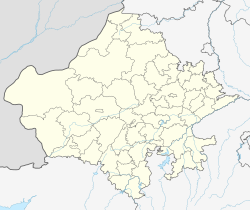Rajgarh Fort
| Rajgarh Fort | |
|---|---|
| Native name राजगढ़ का क़िला (Hindi) | |
 View of Rajgarh Fort atop the Aravalli Hills | |
| Type | Hill fort |
| Location | Rajgarh, Alwar, Alwar district, Rajasthan, India |
| Coordinates | 27°14′03″N 76°36′55″E / 27.2343°N 76.6152°E |
| Area | Approximately 10 hectares |
| Built | Mid-18th century (circa 1730–1740) |
| Architect | Unknown (attributed to Jat military engineers) |
| Architectural style(s) | Jat military with Rajput and Indo-Islamic influences |
| Governing body | Archaeological Survey of India (ASI) |
| Owner | Original: Maharaja Suraj Mal Current owner: Archaeological Survey of India |
Location in Rajasthan | |
Rajgarh Fort,[1][2] is a historic fortification situated in the Aravalli Hills near Rajgarh town, Alwar district, Rajasthan, India, at approximately 27°14'N 76°37'E, with an elevation of 479 meters (1,571 feet). The fort, now in ruins due to decades of abandonment, is maintained by the Archaeological Survey of India (ASI), . Initially constructed in the mid-18th century (circa 1730s–1740s) by Maharaja Suraj Mal of Bharatpur, during campaigns against the Kachwaha dynasty.[3]
History
Early Foundation
According to a historical account of Rajgarh Fort, its construction began under Maharaja Suraj Mal following prolonged conflicts with the Kachwaha army. However Some of tribal Jat chieftains from Alwar’s outskirts, utilising their deep knowledge of the terrain and strong community backing, outmaneuvered the Kachwaha’s, effectively undermining their regional authority. This victory enabled Suraj Mal to establish the fort as a defensive garrison, significantly improvising the Jat influence in Rajasthan.
Under Naruka rule (1771-1949)
After the expeditious declination of Jat rule, In 1771, the fort was takeover by the Naruka clan of Rajputs, led by Raja Pratap Singh Naruka, who subjugated the Alwar State[4] with British support. The Narukas, through treaties facilitated by the British East India Company, consolidated power, making Rajgarh Fort the capital of Alwar until the capital shifted to Bala Quila. Under Naruka rule, the fort served as a summer residence for the Alwar royal family, reflecting their alignment with colonial interests.[citation needed]
See also
References
- ^ Khān, Muḥammad Hāshim Khāfī (2006). Muntakhab-ul Lubab. Sang-e-Meel Publications. p. 132. ISBN 978-969-35-1882-5.
After supersession at Alar they left the fort of Jat, in the district of Rajgarh, went to Jinji and other strong places.
- ^ Elliot, Sir Henry Miers (1962). The History of India, as Told by Its Own Historians: the Posthumous Papers of the Late Sir H.M. Elliot. Susil Gupta. p. 155.
Ram Raja, brother of Sambha Having left the Fort of Jat in the district of Rajgarh
- ^ The India Magazine of Her People and Culture. A. H. Advani. 1987. p. 57.
defending party of Kacchawahas against the jats rewarded (Surajmal) with permission to build the fort at Rajgarh.
- ^ Ratnawat, Shyam Singh (1990). Rajput Nobility: With Special Reference to the Kachchawaha Nobility of Jaipur During 1700-1858 A.D. Panchsheel Prakashan. p. 71. ISBN 978-81-7056-057-9.


